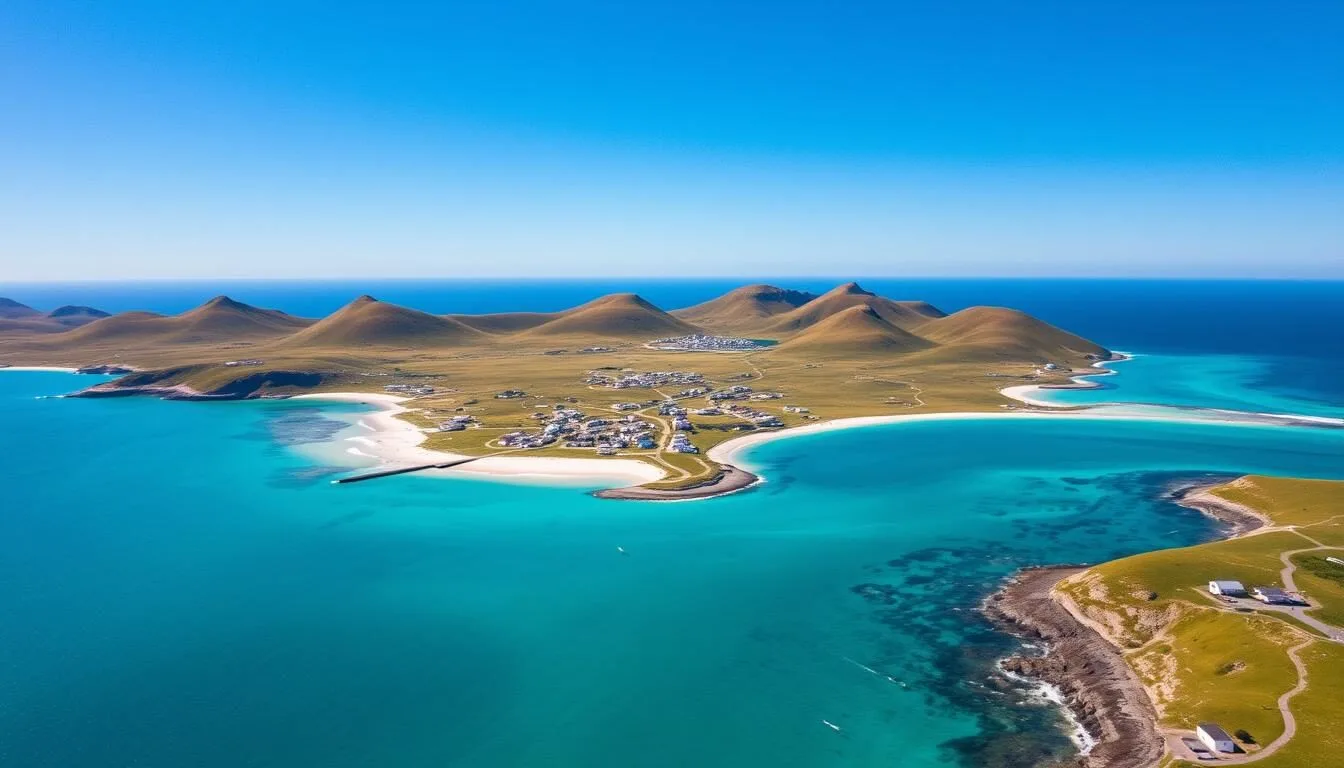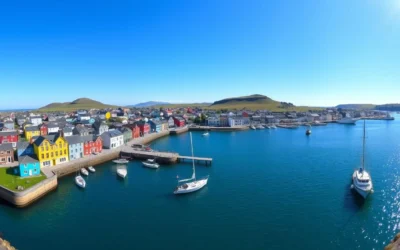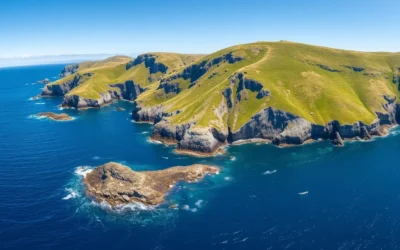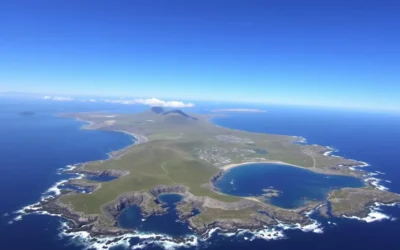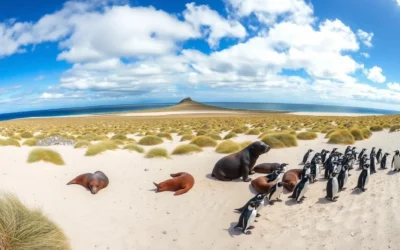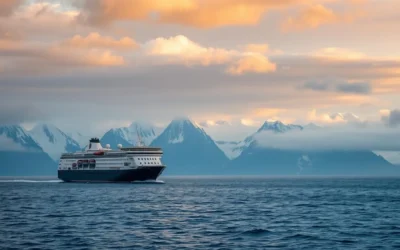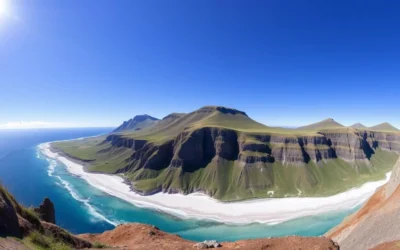Did you know that Carcass Island is one of the few places in the world completely free of rats and cats? This remarkable conservation success has created a wildlife paradise where rare birds like the endemic Cobb’s wren thrive in numbers not seen elsewhere in the Falklands. Located in the northwest of the archipelago, this pristine island offers visitors an authentic glimpse into an ecosystem largely untouched by invasive predators, making it a birdwatcher’s dream and nature lover’s paradise.
Getting to Carcass Island & Planning Your Journey
Reaching Carcass Island requires some planning, but the journey is part of the adventure. The island sits off the northwest tip of West Falkland and is accessible only by air or sea.
By Air
The most common route begins with an international flight to Mount Pleasant Airport on East Falkland. LATAM operates weekly flights from Santiago, Chile (with a stopover in Punta Arenas), while a second weekly flight now connects from São Paulo, Brazil. From the UK, the RAF Airbridge offers flights twice weekly from Brize Norton.
Find Your Flight to the Falklands
Compare prices and book your international flight to Mount Pleasant Airport.
Once in the Falklands, you’ll need to take a FIGAS (Falkland Islands Government Air Service) flight to Carcass Island. These small planes operate like an air taxi service between islands, with schedules confirmed the day before travel.
By Sea
Many visitors arrive via expedition cruise ships that include Carcass Island on their Falklands itinerary. These cruises typically depart from Ushuaia (Argentina), Punta Arenas (Chile), or Port Stanley (Falklands). Landings are usually made by Zodiac boats to the beach, followed by a guided walk to the settlement.
For independent travelers already in the Falklands, charter boats can sometimes be arranged from Port Howard or other nearby settlements.
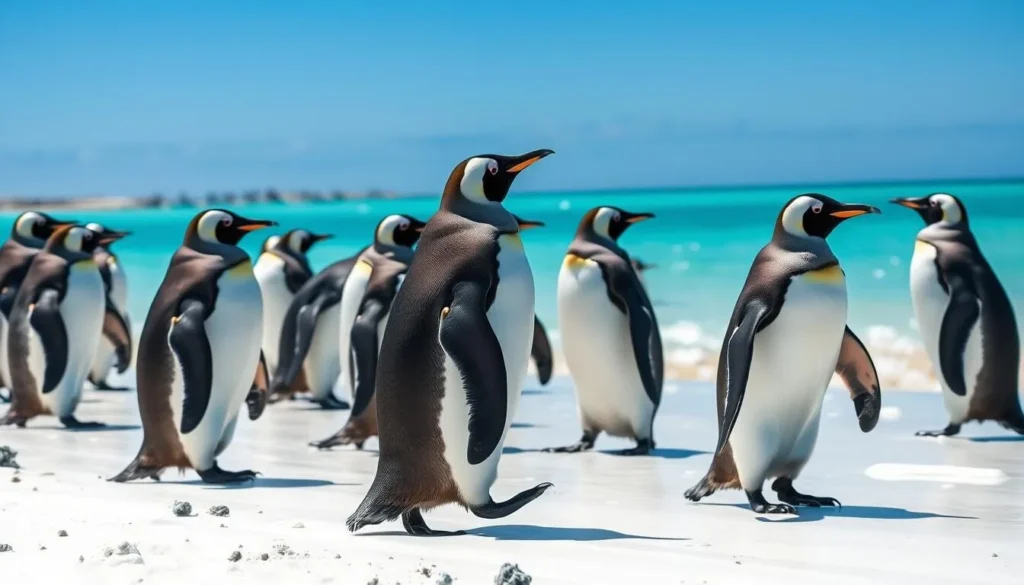
Best Time to Visit & Weather Tips
The Falkland Islands experience a subpolar oceanic climate, with Carcass Island enjoying relatively mild conditions compared to the Antarctic region further south.
Peak Season (November to February)
The austral summer brings the most favorable weather and peak wildlife activity. Temperatures typically range from 10-15°C (50-59°F). This period offers:
- Maximum daylight hours (up to 18 hours in December)
- Penguin breeding season with chicks hatching in December-January
- Peak flowering of native plants including the rare yellow orchid
- Best conditions for photography and hiking
Shoulder Seasons (October and March-April)
These months offer fewer visitors but still good wildlife viewing. Temperatures average 5-12°C (41-54°F). October sees the arrival of breeding birds, while March-April showcases elephant seal pups and departing migratory birds.
Winter (May to September)
Winter brings shorter days, stronger winds, and temperatures averaging 2-7°C (36-45°F). While some wildlife remains year-round, transportation options become more limited, and many accommodations close for the season.
Weather Tip: Regardless of when you visit, pack layers and waterproof clothing. The Falklands are known for rapidly changing weather conditions, and strong winds can make temperatures feel much colder than they actually are.
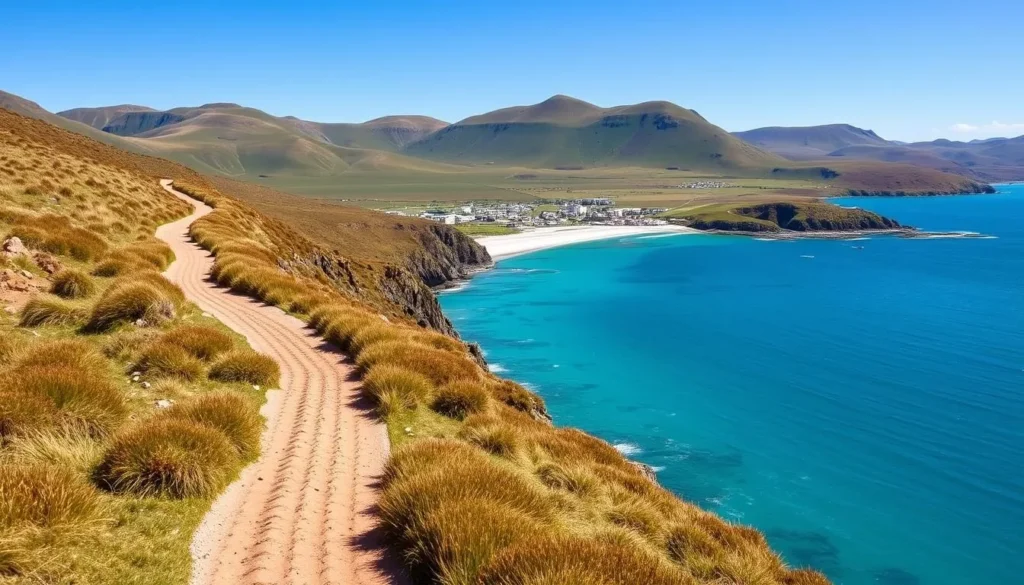
Getting Around Carcass Island
Carcass Island is relatively small at just 4.5 miles (7.2 km) long, making it perfect for exploration on foot. There are no paved roads, public transportation, or vehicle rentals on the island.
Walking
Walking is the primary and most rewarding way to explore Carcass Island. Well-worn paths connect the main points of interest, and the terrain is generally gentle with some moderate hills. A reasonable level of fitness is recommended for longer walks.
Guided Tours
The island’s owners or staff often provide guided walks for visitors, especially those arriving on cruise ships. These tours offer valuable insights into the island’s ecology, history, and wildlife.
4×4 Transport
For longer journeys across the island, the owners may provide 4×4 transport for guests staying at the lodge. This is particularly helpful for reaching more distant beaches or viewpoints.
Explore the Falklands
For mainland Falklands exploration before or after your Carcass Island visit, consider renting a 4×4 vehicle in Stanley.
Navigation Tip: There are few marked trails on the island. When exploring independently, take a map (available from the lodge), compass, and consider using offline GPS apps. Always inform someone at the lodge of your planned route and expected return time.
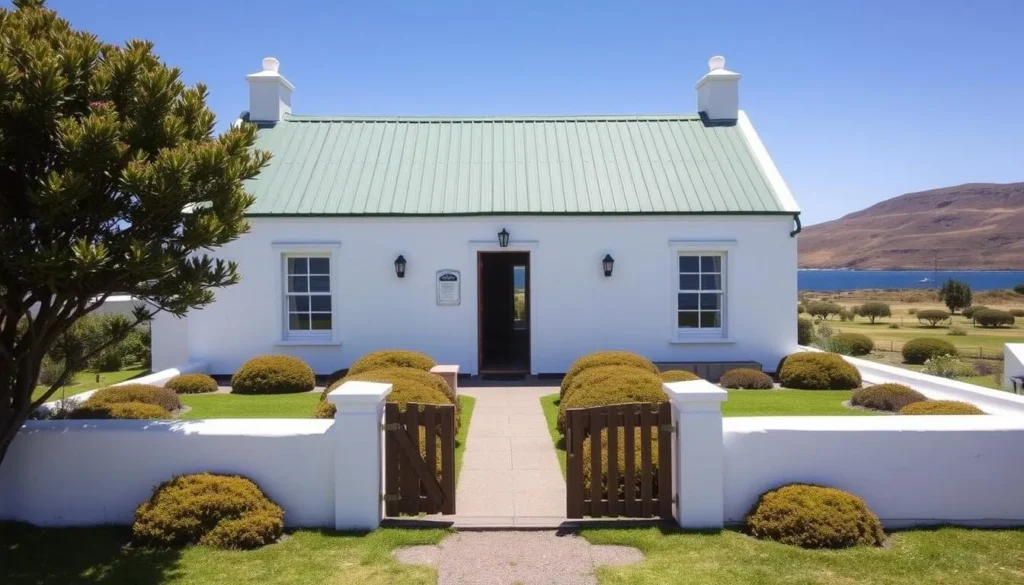
Where to Stay on Carcass Island
Accommodation options on Carcass Island are limited but charming, offering an authentic Falklands experience with warm hospitality.
Carcass Island House
The main accommodation option is Carcass Island House, a comfortable guest house run by the island’s owners. This traditional Falklands farmhouse offers:
- Cozy rooms with shared or private bathrooms
- Home-cooked meals featuring local ingredients
- Spectacular views of the harbor and surrounding landscape
- A warm, communal atmosphere where guests dine together
- Wi-Fi available through prepaid cards (though connection can be intermittent)
The house accommodates a limited number of guests, ensuring a personal experience. Advance booking is essential, especially during peak season (November-February).
Book Your Falklands Accommodation
Secure your stay at Carcass Island House or other Falklands accommodations for before/after your island visit.
Camping
While camping is technically possible on Carcass Island, it requires advance permission from the owners and is subject to strict conservation guidelines. Most visitors opt for the comfort and convenience of staying at the main house.
“Dinner time at the lodge is when the magic happens. After a day of exploring, everyone gathers around the table, sharing stories from their adventures. It’s this social aspect of staying on Carcass Island that creates some of the most memorable moments.”
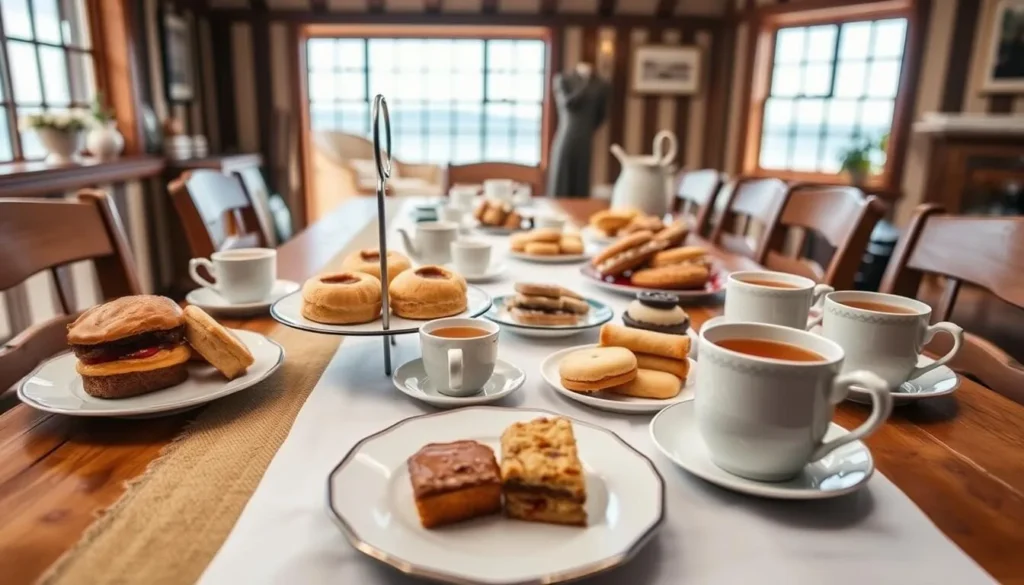
Dining & Local Cuisine on Carcass Island
Dining on Carcass Island is a straightforward but delightful experience centered around the guest house. All meals are provided for staying guests, with no restaurants or cafes on this remote island.
Meals at Carcass Island House
The guest house serves hearty, home-cooked meals that showcase local ingredients and traditional Falklands cooking. Expect:
- Breakfast: Full English-style breakfast with eggs, bacon, toast, and cereals
- Lunch: Homemade soups, sandwiches, or light hot meals
- Dinner: Three-course meals often featuring local lamb, fresh fish, or homegrown vegetables
- Afternoon tea: A Falklands tradition with homemade cakes and biscuits
Meals are served family-style, with all guests dining together at set times. This creates a wonderful social atmosphere where you can share the day’s experiences with fellow travelers.
Famous “Smoko”
Cruise ship visitors to Carcass Island often rave about the legendary “smoko” (afternoon tea) served at the farmhouse. This spread of homemade cakes, cookies, and sandwiches has become famous among expedition cruisers as one of the best culinary experiences in the Falklands.
Dietary Requirements: If you have specific dietary needs, it’s essential to communicate these well in advance. The remote location means supplies are limited, but the hosts will do their best to accommodate requirements with sufficient notice.
Self-Catering
There are no shops on Carcass Island, so self-catering is not an option. All provisions must be brought from Stanley if not taking meals at the guest house, which is rarely practical for most visitors.
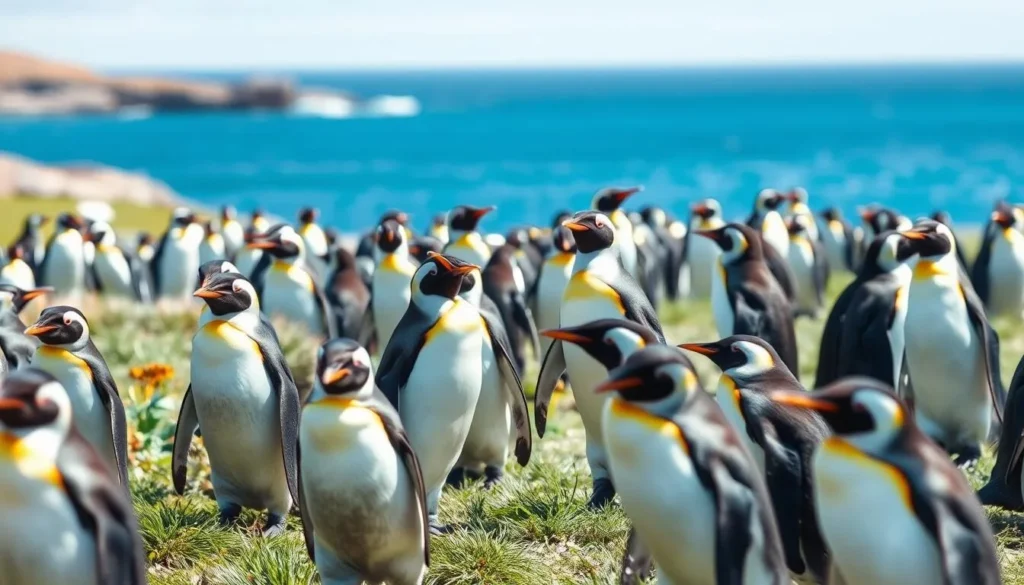
Wildlife Viewing on Carcass Island
Wildlife viewing is the primary attraction on Carcass Island, with the island’s predator-free status creating a haven for birds and marine mammals. The absence of rats and cats has allowed ground-nesting birds to flourish in numbers rarely seen elsewhere.
Penguin Colonies
Carcass Island is home to two penguin species:
- Gentoo Penguins: Found nesting in the tussac grass above Dyke Bay and Leopard Beach, these medium-sized penguins are recognizable by their bright orange bills and white eye patches.
- Magellanic Penguins: These burrowing penguins nest along the edges of the beaches, typically more active in early morning and evening hours.
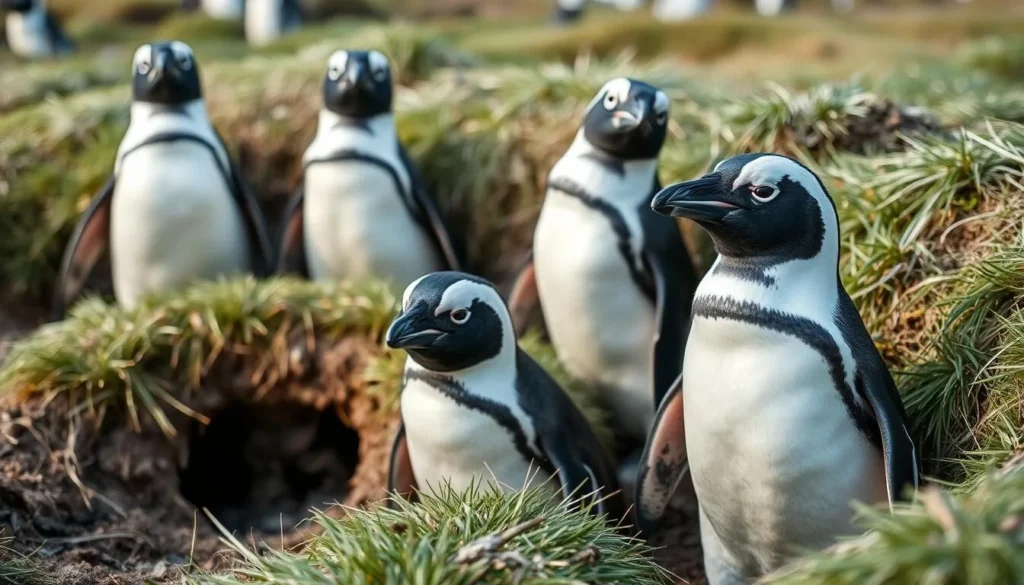
Endemic and Rare Birds
Carcass Island is internationally recognized as an “Important Bird Area” and is especially known for its songbirds:
- Cobb’s Wren: This endemic species is found almost exclusively on rat-free islands. Carcass Island offers one of the best opportunities to spot these small, brown birds hopping along the shoreline.
- Tussacbird: These curious, friendly birds often approach visitors and may even land on your shoes or backpack.
- Striated Caracara (Johnny Rook): An impressive bird of prey known for its intelligence and bold behavior. Keep a close eye on your belongings as they’re known to steal unattended items!
- Long-tailed Meadowlark: Recognizable by its bright red breast and distinctive, joyful call.
- Falkland Steamer Duck: Often seen along the shoreline, these flightless ducks “steam” through the water using their wings and feet.
Book a Wildlife Tour
Enhance your wildlife experience with expert guides who can help you spot and identify the island’s unique species.
Marine Mammals
The waters around Carcass Island are home to various marine mammals:
- Elephant Seals: Often found lounging on beaches, particularly near the airstrip.
- Sea Lions: Frequently spotted in the harbor and along rocky shorelines.
- Dolphins: Commerson’s and Peale’s dolphins are sometimes seen in the surrounding waters.
- Fur Seals: Occasionally found hiding in the tall tussac grass along the coast.
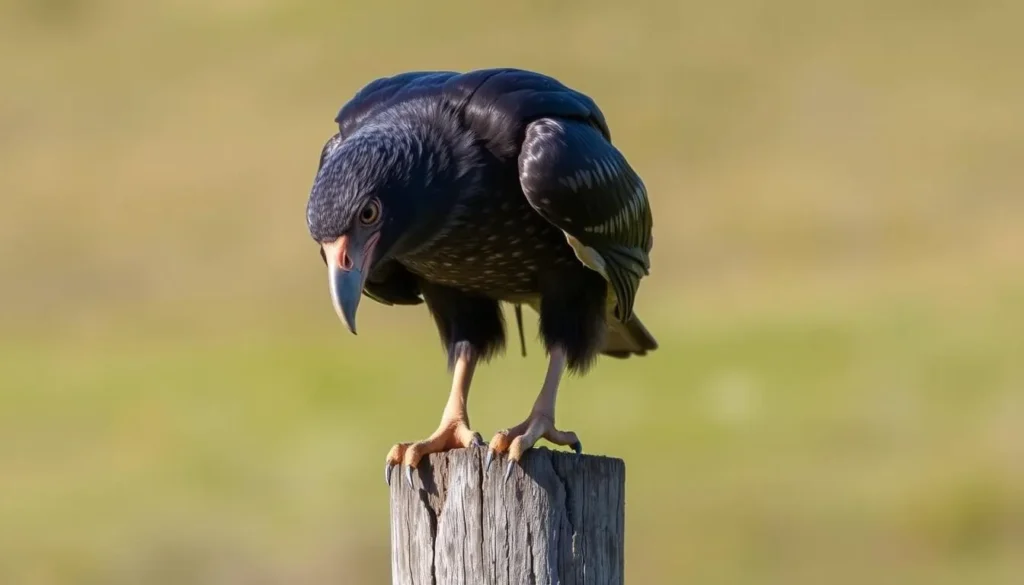
Wildlife Viewing Tip: Early morning and late afternoon offer the best wildlife viewing opportunities when many species are most active. Bring binoculars and a camera with a zoom lens to capture the island’s diverse birdlife without disturbing them.
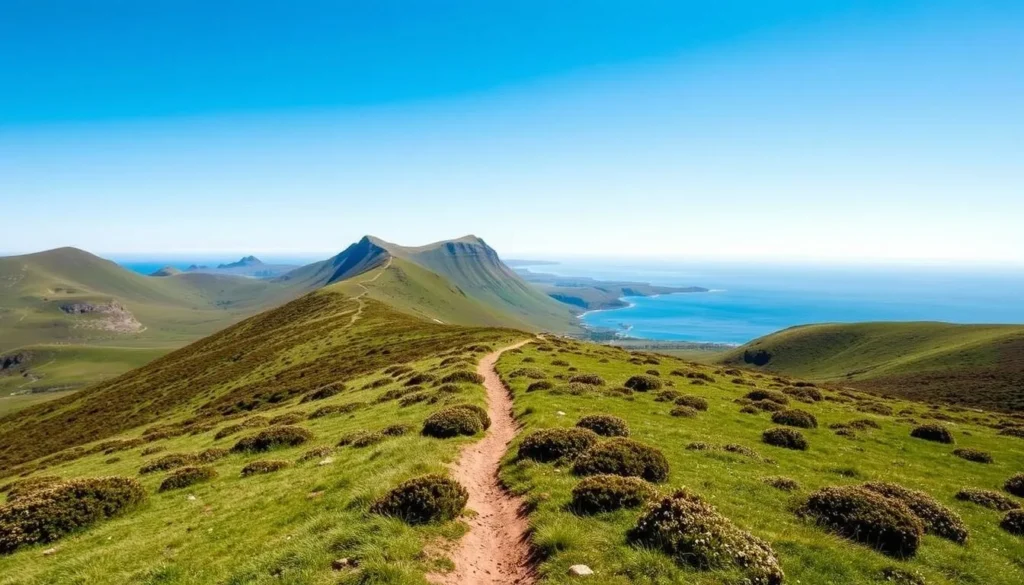
Hiking Trails and Natural Attractions
Carcass Island offers excellent hiking opportunities with varied terrain and spectacular views. The island’s compact size means most locations can be reached within a day’s walk from the settlement.
Popular Hiking Routes
- Stanley Hill: A quick but strenuous hike up this nearby hill rewards with panoramic views of the settlement and harbor. Perfect for sunset photography.
- Leopard Beach: A longer, gentler walk to one of the island’s most beautiful beaches. Great for wildlife spotting along the way.
- Mount Byng: At 213 meters (700 feet), this is the highest point on the island. The challenging climb offers spectacular 360-degree views of Carcass and neighboring islands.
- Elephant Flats: Continue past Mount Byng to reach this area where elephant seals can often be found lounging on the beach.
- The Needles Viewpoint: A moderate walk to see the distinctive chalky-white rock formations jutting from the sea.
Natural Features
Beyond the wildlife, Carcass Island boasts impressive natural landscapes:
- Tussac Grass: These tall grass formations create miniature forests that shelter various bird species and occasionally fur seals.
- Pristine Beaches: White sandy beaches with crystal-clear waters line parts of the coastline.
- Diverse Flora: Over 107 different plant species have been identified on the island, including the rare yellow orchid and hairy daisy.
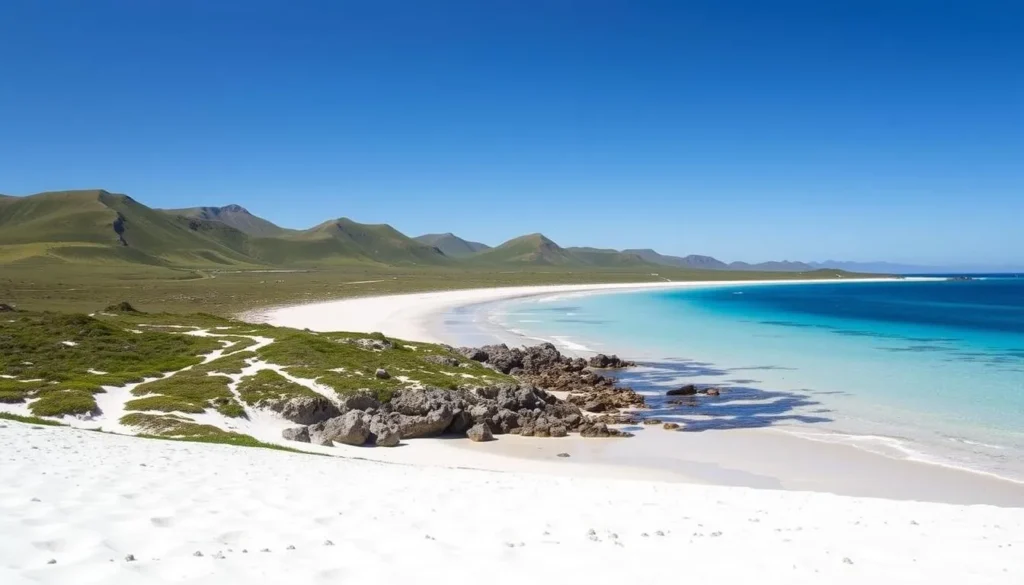
Hiking Safety: When hiking on Carcass Island, always inform someone at the lodge of your planned route and expected return time. Weather can change rapidly, so carry appropriate clothing, water, and emergency supplies. Stay on established paths where possible to protect fragile vegetation and nesting birds.
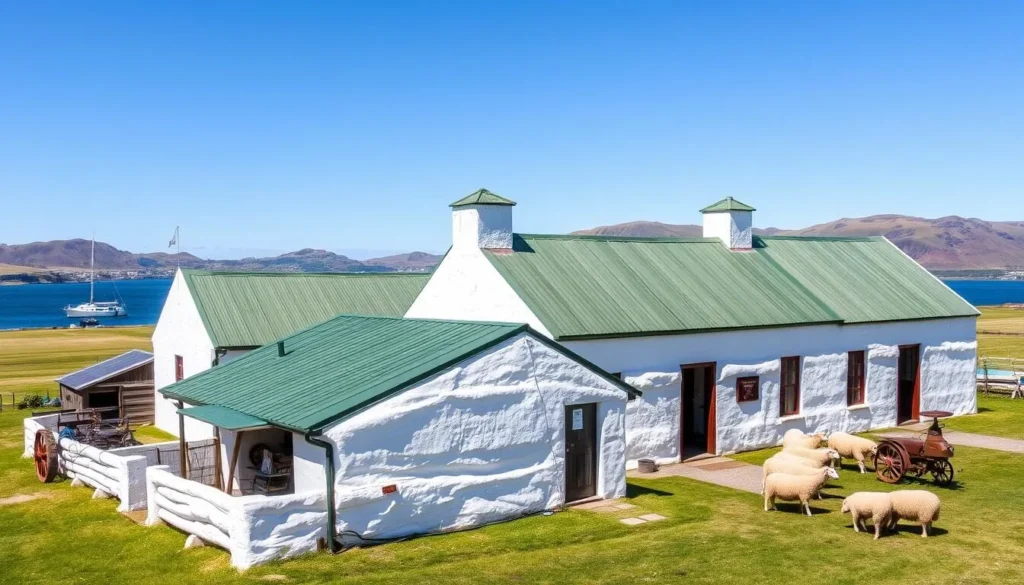
History and Heritage of Carcass Island
Carcass Island has a fascinating history that reflects the broader story of the Falkland Islands’ development.
Naming and Early History
The island was named after HMS Carcass, a Royal Navy ship that surveyed the area in 1766. Despite its somewhat grim-sounding name, there’s nothing macabre about this beautiful island. It remained uninhabited until the mid-19th century when British settlers began establishing sheep farms throughout the Falklands.
Sheep Farming Legacy
For over a century, Carcass Island has operated as a sheep farm. The current farm continues this tradition while balancing agricultural activities with conservation efforts. Visitors can often observe farm operations and, depending on the season, may even have the opportunity to help with some tasks if interested.
Conservation Success Story
Unlike many other Falkland Islands, Carcass Island has remained free of introduced predators like rats and cats. This conservation success has created a sanctuary for ground-nesting birds and contributed to the island’s international recognition as an Important Bird Area.
The careful management by successive owners has preserved both the natural environment and the cultural heritage of traditional Falklands farming life, creating the unique experience visitors enjoy today.
Practical Travel Tips for Carcass Island
What to Pack
- Layered Clothing: Weather can change rapidly, so bring waterproof outer layers, warm mid-layers, and base layers.
- Sturdy Hiking Boots: Essential for exploring the island’s terrain.
- Binoculars: A must for wildlife viewing.
- Camera Equipment: Bring extra batteries and memory cards as there are no shops on the island.
- Sunscreen and Hat: The Falklands sun can be surprisingly strong, and there’s little shade on the island.
- Insect Repellent: For the occasional midges in summer months.
Practical Information
- Currency: Falkland Islands Pound (FKP), interchangeable with British Pound (GBP). No ATMs on Carcass Island, so bring cash from Stanley.
- Electricity: 240V with UK-style three-pin plugs. Bring adapters if needed.
- Communication: Limited Wi-Fi available through prepaid cards. Mobile phone coverage is minimal to non-existent.
- Medical: No medical facilities on the island. Bring any necessary medications and a basic first aid kit.
- Time Zone: Falkland Islands Time (FKT), which is UTC-3.
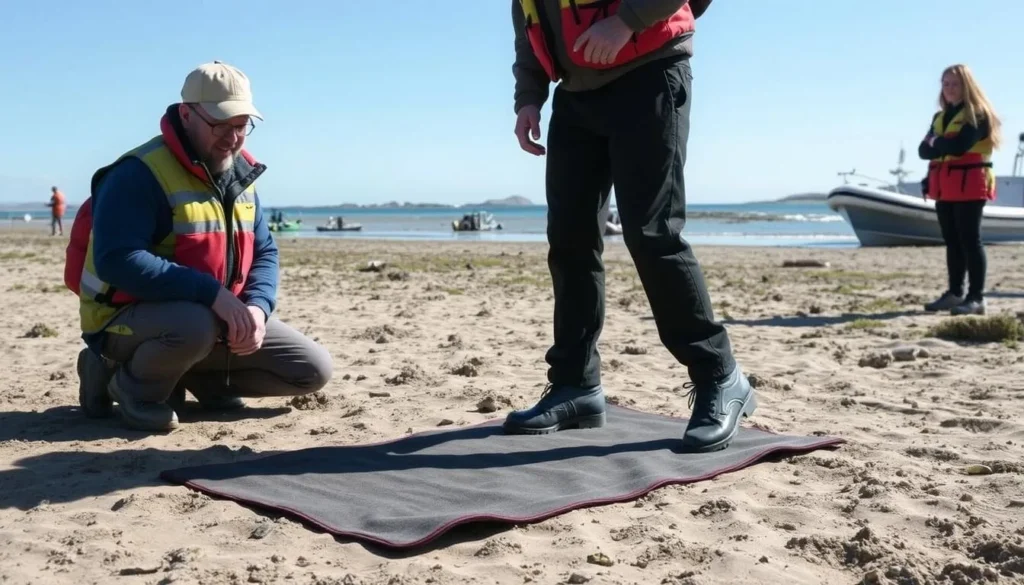
Biosecurity and Conservation
Carcass Island’s rat-free status is crucial for its wildlife. Visitors must follow strict biosecurity protocols:
- Clean all gear, especially footwear, before landing on the island
- Check clothing for seeds or plant material
- Never bring food items ashore unless specifically permitted
- Follow all guidance from local hosts or expedition leaders
Wildlife Viewing Etiquette
To protect the island’s wildlife and ensure their continued well-being:
- Maintain at least 5 meters distance from wildlife (more for nesting birds)
- Never block an animal’s path to the sea or its nest
- Walk slowly and speak quietly near wildlife
- Be especially careful around Magellanic penguin burrows to avoid collapse
- Never feed any wildlife
Important: Carcass Island has limited facilities and no shops, medical services, or emergency responders. Self-sufficiency and proper preparation are essential for a safe and enjoyable visit.
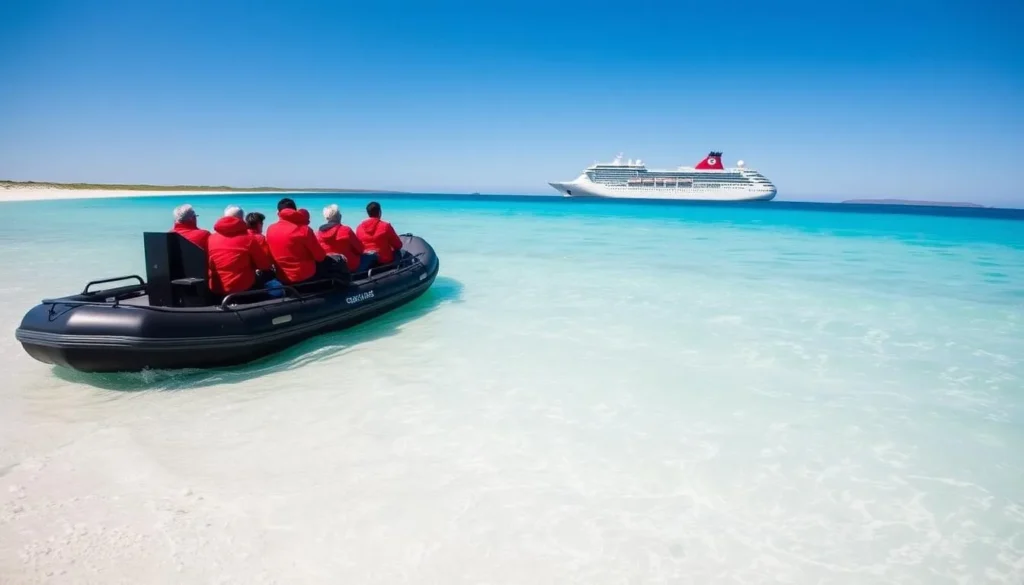
Plan Your Carcass Island Adventure
Ready to experience the natural wonders of Carcass Island? Here are the key resources to help you plan your perfect Falklands adventure.
Transportation
Book your international flights to the Falklands and arrange internal FIGAS flights or expedition cruises that include Carcass Island.
Accommodation
Secure your stay at Carcass Island House or other Falklands accommodations for before/after your island visit.
Tours & Activities
Enhance your experience with guided wildlife tours, photography excursions, or multi-island Falklands packages.
Suggested Itineraries
Weekend Escape (3 Days)
- Day 1: Arrive via FIGAS, settle in at Carcass Island House, afternoon walk to Stanley Hill
- Day 2: Full-day exploration of penguin colonies and hiking to Mount Byng
- Day 3: Morning beach walk to spot Cobb’s wren, afternoon departure
Wildlife Immersion (5-7 Days)
- Days 1-2: Arrival and settlement exploration, penguin colonies
- Day 3: Day trip to West Point Island to see albatross colony (weather permitting)
- Days 4-5: Hiking to remote beaches and Mount Byng
- Days 6-7: Photography focus on rare birds, final explorations, departure
How do I book a stay on Carcass Island?
Bookings for Carcass Island House are managed by the island owners. The best approach is to contact the Falkland Islands Tourist Board who can provide current contact information and assist with arrangements. Alternatively, tour operators specializing in Falklands travel can organize your stay as part of a package.
Can I visit Carcass Island as a day trip?
Day trips to Carcass Island are possible but challenging to arrange independently. The most common day visits are part of expedition cruise itineraries. If staying elsewhere in the Falklands, you might arrange a day trip via FIGAS, but this depends on flight schedules and availability.
What wildlife am I guaranteed to see?
While wildlife sightings can never be guaranteed, Carcass Island offers very reliable viewing of gentoo and Magellanic penguins, various songbirds including the endemic Cobb’s wren, and often elephant seals. The island’s compact size and abundant wildlife mean you’re likely to have excellent sightings even on a short visit.
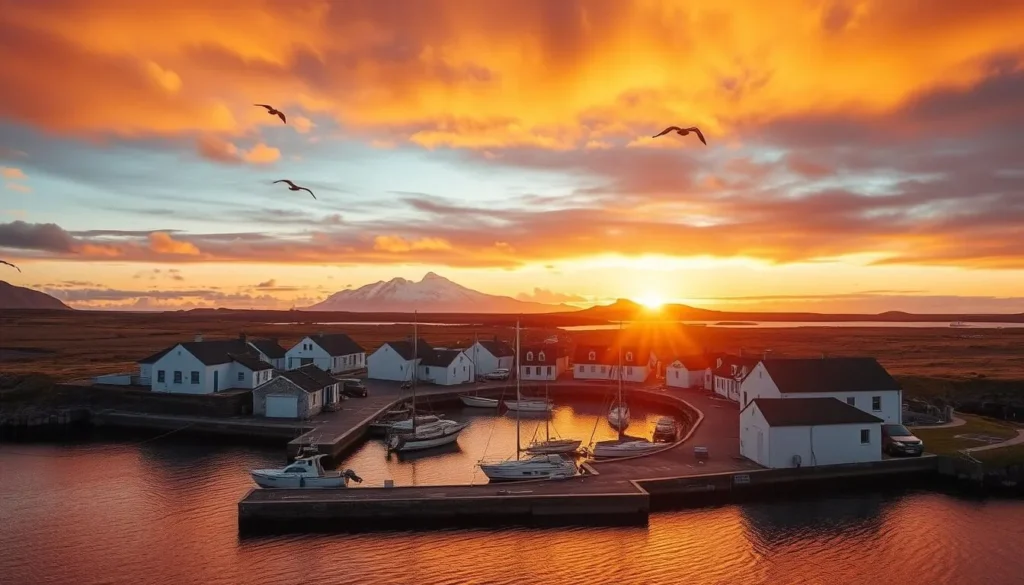
Experience the Magic of Carcass Island
Carcass Island represents one of the last truly unspoiled wildlife havens on our planet. Its unique status as a predator-free island has created an extraordinary ecosystem where birds and marine mammals thrive in harmony with sustainable farming practices that span over a century.
Whether you’re an avid birdwatcher seeking the endemic Cobb’s wren, a photographer hoping to capture the perfect penguin portrait, or simply a traveler looking to disconnect from the modern world and reconnect with nature, Carcass Island offers an authentic experience that few destinations can match.
The island’s remote location and limited visitor capacity ensure that those who make the journey are rewarded with uncrowded beaches, personal wildlife encounters, and the warm hospitality of Falkland Islanders. In an age of overtourism, Carcass Island remains a genuine escape—a place where nature sets the pace and visitors leave with not just photographs, but a deeper appreciation for our natural world.
Start planning your Carcass Island adventure today and discover why this small island in the South Atlantic has captured the hearts of travelers from around the world.
Ready for Your Falklands Adventure?
Begin your journey to this remarkable wildlife paradise with our trusted travel partners.
The above is subject to change.
Check back often to TRAVEL.COM for the latest travel tips and deals.
